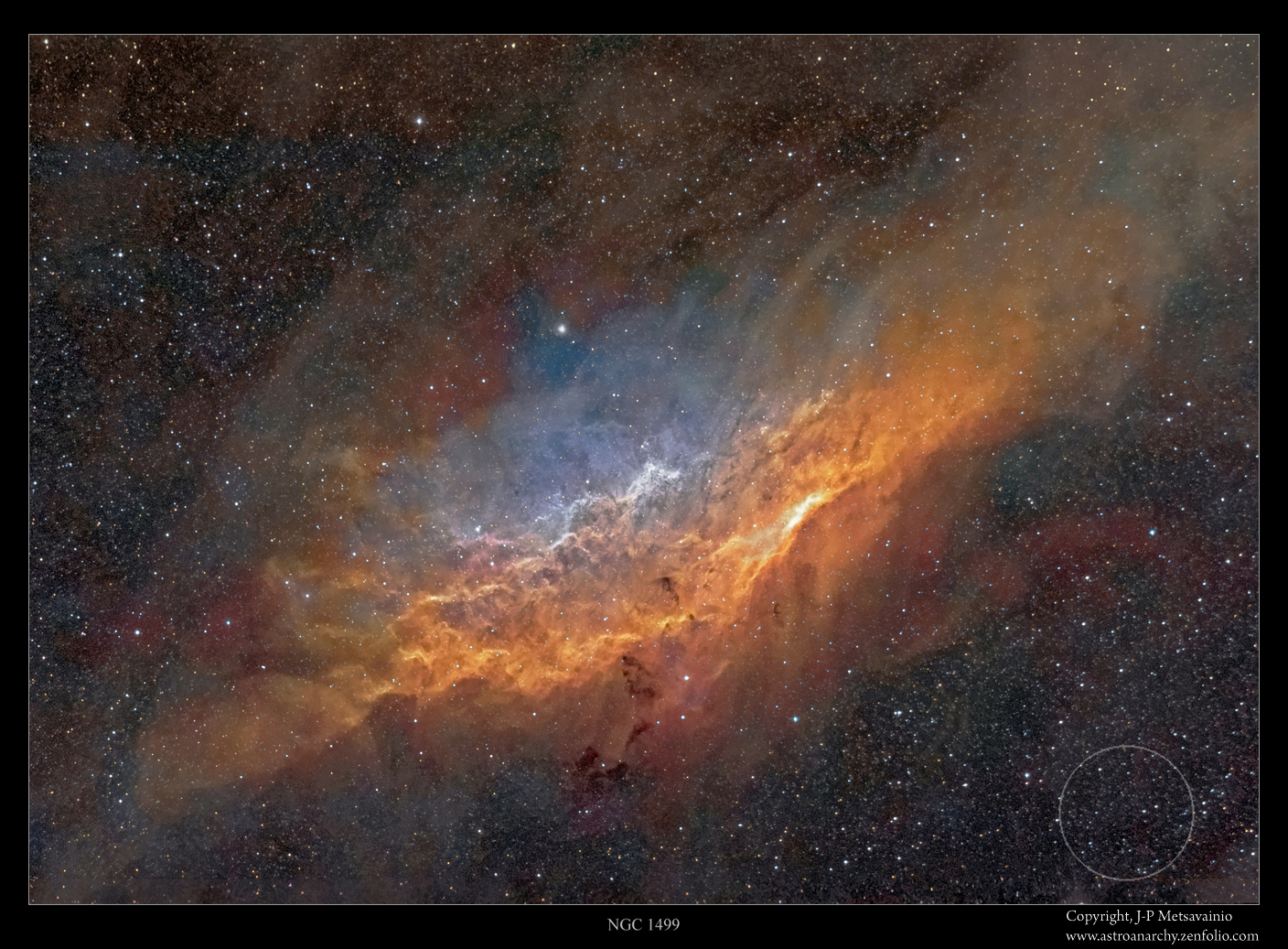COPYRIGHT, PLEASE NOTE
All the material on this website is copyrighted to J-P Metsavainio, if not otherwise stated. Any content on this website may not be reproduced without the author’s permission.
Have a visit in my portfolio
PORTFOLIO:https://astroanarchy.zenfolio.com/
Saturday, January 9, 2016
NGC 1499, the California Nebula
At the night of January 4. I was shooting exposures for the Filaments of Cygnus image. After few hours the constellation Cygnus was getting too low in the horizon and I had to select a new target for rest of the night, the NGC 1499.
Detail of the NGC 1499
Please, click for a large image
Image area spans about one degree of sky. The photo is in mapped colors from the light
emitted by an ionized elements, red=sulfur, green=hydrogen and blue=oxygen.
Please, click for a large image
A wide field image of the NGC 1499 from January 2012 was shot with a Tokina AT-X 200mm f2.8 lens, QHY9 astrocamera and Baader narrowband filter set. The white circle at lower right corner shows an apparent size of the full Moon at the same scale. (Moon has an apparent diameter of 0.5 degrees = 30 arc minutes.) This is a large target with a lowish surface brightness, total exposure time is around 30h.
INFO
The California Nebula is an emission area located in constellation Perseus. It appears to resemble outlines of State of California on long exposure photographs, like this one. It has a very low surface brightness and it's very difficult to observe visually. Distance from my hometown Oulu, Finland, is about 1000 light years.
this image spans around five degrees horizontally. The Wikipedia article states, that the angular size is about 2,5 degrees (Five full Moons side by side) but as can be seen in this image, the actual size, with a dim outer parts, is much large.
Detail of NGC 1499 at visual colors
Natural color composition from the emission of ionized elements, R=80%Hydrogen+20%Sulfur, G=100%Oxygen and B=85%Oxygen+15%Hydrogen to compensate otherwise missing H-beta emission. This composition is very close to a visual spectrum.
Technical details
Processing work flow
Image acquisition, MaxiDL v5.07.
Stacked and calibrated in CCDStack2.
Deconvolution with a CCDStack2 Positive Constraint, 21 iterations, added at 25% weight
Color combine in PS CS3
Levels and curves in PS CS3.
Imaging optics
Celestron Edge HD 1100 @ f7 with 0,7 focal reducer for Edge HD 1100 telescope
Mount
10-micron 1000
Cameras and filters
Imaging camera Apogee Alta U16 and Apogee seven slot filter wheel
Guider camera, Lodestar x2 and SXV-AOL
Astrodon filter, 5nm H-alpha
Astrodon filter, 3nm O-III
Astrodon filter, 3nm S-II
Exposure times
H-alpha, 15 x 1200s =5h
O-III, 3 x 1200s binned = 1h
S-II, 3 x 1200s binned = 1h
Total 7h
Some S-II and O-III signal is borrowed from the older wide field photo.
Labels:
Narrowband color images,
nebula
Subscribe to:
Post Comments (Atom)













1 comment:
Utterly beautiful. I am never not amazed by... That which is in actuality beyond anything I can...
Post a Comment